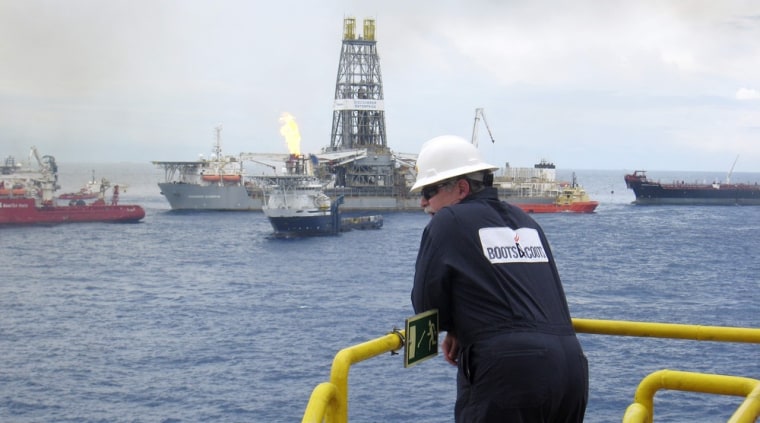Crews working to seal BP's blown-out well in the Gulf of Mexico once and for all need to finish one more pressure test on a cement plug before declaring the well permanently dead, officials said Saturday.
Once the pressure test is finished and officials are confident the seal will hold permanently, the well will be declared dead, said Rich Robson, the offshore installation manager on the Development Driller III vessel. He said the 74 barrels of cement pumped in Friday have dried.
Crews were pulling out 2,300 feet of pipe, after which the pressure test could begin around 11 p.m. CDT. It will last for about 30 minutes, during which the cement plug — about 1,000 feet long — must withstand pressure of 1,150 pounds per square inch.
Once the test is finished, if the plug holds, retired Coast Guard Adm. Thad Allen, who is overseeing the government's response to the spill, will declare the well dead.
The vessel was used to drill the relief well that allowed engineers to pump in the cement. That relief well, 2.5 miles beneath the seafloor, intersected BP's well on Thursday.
The crew plans to celebrate once the well is officially killed. "We're going to have a good meal together — prime rib," Robson said.
Engineers initially had planned to pump in mud before the cement, but a BP spokesman said that wasn't necessary because there was no pressure building inside the well.
Once the well is declared dead, it will mark the first time in five months that Gulf Coast residents can be completely assured oil will never spew from the well again. The catastrophe began April 20, when an explosion killed 11 workers, sank a drilling rig and led to the worst offshore oil spill in U.S. history.
The relief well was the 41st successful drilling attempt by John Wright, a contractor who led the team drilling the relief well aboard the Development Driller III vessel. Wright, who has never missed his target, said in August that he was looking forward to finishing the well and celebrating with a cigar and a quiet getaway with his wife.
"I am ready for that cigar now," Wright said in an e-mail Friday to the AP from aboard the DDIII.
The Gulf well spewed 206 million gallons (780 million liters) of oil until the gusher was first stopped in mid-July with a temporary cap. Mud and cement were later pushed down through the top of the well, allowing the cap to be removed. But officials will not declare it dead until it is sealed from the bottom.
BP PLC is a majority owner of the well and was leasing the rig from owner Transocean Ltd.
The oil spill was an environmental and economic nightmare for people along the Gulf Coast that has spawned civil and criminal investigations. It cost gaffe-prone BP chief Tony Hayward his job and brought increased governmental scrutiny of the oil and gas industry, including a costly moratorium on deepwater offshore drilling that is still in place.
With oil still in the water — some of it still washing ashore — people continue to struggle. Fishermen are still fighting the perception their catch is tainted, and tourism also has taken a hit.
